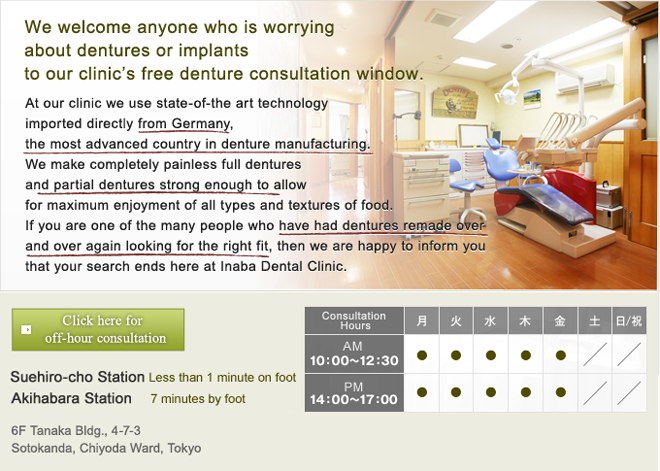トップへ » Considering Dentures? » Different from Insurance Covered Dentures
How do our dentures differ from ones covered by insurance?
Concerning full dentures covered by insurance, it is possible to have soft dentures made within the scope of health care services provided by health insurance. So why don't we recommend those dentures at our clinic? There are a few reasons.
First, the greatest difference is the knowledge that our specialist dentists and technicians possess.
In order to learn German denture technology with a long history, our dentists and technicians are required to possess vast stores of high-caliber knowledge in their field. They cover every possible angle to design dentures for our patients that can be used for a long time.
The condition of patients' teeth is never the same
There are many differences in bone condition, the presence or absence of nerves, number of teeth, tooth position, and many other variables. You should be aware that there is no guarantee that you are getting the best design possible with health insurance-covered dentures since they are limited by design parameters and rules.
Also, materials are a problem
Since insurance-covered dentures are made with a soft resin, they absorb stains from food, coffee, and tobacco. Stains and foul smells sink into the resin and may cause bad breath. Also, prosthetic teeth are limited to prefabricated plastic teeth. They lack the hardness and grooves that occur with natural teeth making it difficult to chew and easy for others to notice your dentures simply by looking at them.
Next, there is the problem of time spent making the dentures
Upper and lower molds are sent separately to dental technicians who specialize in making insurance-covered dentures. The technicians never see the faces of the people whom they are making dentures for. They also use the most economically reasonable materials. Since the muscles of the mouth and the gums are not considered at all, many dentures made in this manner unfortunately suffer from weak adsorption and tend to fall out easily.
At our clinic we specialize in materials and production
Dentures not covered by insurance from our clinic are made by technicians who take pride in the materials and methods that they use. They use the best materials available to meet each patient's needs.
High precision Ivocup System
First of all, for materials, we use a low-water absorbing material that doesn't let smells or stains soak in, making our dentures more hygienic. This is because we use the high precision Ivocup System which applies 2 tons of pressure to the resin making our dentures thinner yet stronger and more resistant to water absorption.
Artificial teeth from Liechtenstein Ivoclar nearly indistinguishable from natural teeth
We use Liechtenstein Ivoclar artificial teeth which as functional as real teeth and we allow you to choose from a large selection of colors. These teeth feature strong natural grooves that allow you to crush and grind food as if you were using your natural teeth.
We are able to make detailed fine adjustments quickly since our technician is in-house
Our dental technicians who specialize in constructing non-insurance-covered dentures are located in the annexed dental lab in our clinic. The dentists and technicians work together to make dentures that fit our patients perfectly. Since the technicians are located onsite, we can also quickly handle detailed fine adjustments. Your mouth muscles support these dentures through adsorption making them more secure the wider you open your mouth as you laugh or sing. Rarely can anyone notice patients wearing a set of our dentures and your pronunciation will also improve greatly.
Japanese dentures covered by insurance are not even used overseas
Currently dentures that are covered by Japanese health insurance use metallic springs called clasps. The clasps clip onto the teeth but they do not do so through adhesion.
Because of this, when the dentures move, the teeth move with them, which eventually leads to more teeth coming loose and falling out. Since the teeth are supported by springs, the dentures are constantly moving around in the mouth.
When we dentists extract teeth, we do so by wiggling the problem tooth side to side. This is the exact same movement that the clasps of these dentures causes to the teeth they are latched onto.

^Partial dentures covered by insurance. The metal clasps place a burden on the teeth, which can be seen easily in this image.
In Germany, outdated denture technology that makes use of clasps has already been purged from dental university classes due to the damage they can do to teeth.
Pictured is a comparison of health insurance-covered dentures and dentures made using the maxillomandibular simultaneous impression method
The smaller dentures were made using health insurance. The larger ones are dentures made using the maxillomandibular simultaneous impression method.

You probably can't tell but these are two sets of dentures made for the same person. You can see how much of a difference the manufacturing method makes.
Insurance-covered dentures are made by simply taking a membrane mold which often results in small dentures. They tend to move around in the mouth and in some cases people can even swallow them.
Dentures made using the maxillomandibular simultaneous impression method, however, are made by recording every piece of information possible concerning the inside of the patient's mouth.
Differences between health insurance-covered dentures and dentures made using the maxillomandibular simultaneous impression method
Full dentures made within the scope of health care services provided by health insurance and those paid for out of pocket made using maxillomandibular simultaneous impression method are vastly different.
Of course, dentures covered by insurance will not be perfect as they are limited by materials and amount of time and attention to detail they can spend on each set. Following is an explanation of some of the differences between health insurance-covered dentures and dentures made using the maxillomandibular simultaneous impression method.
Conventional dentures: Demerits of taking the upper and lower jaw molds separately
1. Since the patient opens their mouth and has the upper and lower tooth mold taken separately, errors can occur in placing the mold device in the mouth. As a result of this, the patient must make extra visits to the clinic (anywhere from 6 - 10 times).
2. This method is incapable of recording data concerning the movement of muscles around the mouth, the tongue, and the lips while functioning.
3. It is also incapable of simulating the state of the mouth while eating by measuring movements when the patient swallows saliva.
4. The pressure used to make the mold varies for the upper and lower jaw.
5. The natural pressure of the mouth is different from that used to make the mold since the dentist decides what pressure to use when taking the mold.
6. The natural bite pressure is different from that used to make the mold since the dentist takes the mold manually.
Dentures from our clinic: Merits of using the maxillomandibular simultaneous impression method
1. Since we take precision molds, record bite alignment data, the height of the upper and lower jaw, and tooth position all at once, there is no need to come back for mold taking over and over again like with conventional dentures. *The process is complete in just 3 visits.
2. We make the mold while recording the bite alignment height which achieves an ideal balance.
3. We have you swallow saliva while taking the mold so that we can record the movements of your mouth.
4. We place the model made from your mold as it is into the actuator thus reducing the chance of error.
5. We record information about your mouth muscles, tongue, and lips under natural pressure exerted by you and not the dentist.
6. We can place artificial teeth in well-balanced positioning suited to your mouth.
7. Conventional dentures are prone to fall out with tongue movements since their gum shape was made to extend to reach deep back around the tongue. But with dentures made using the maxillomandibular simultaneous impression method, the area in front of the tongue is used effectively. This makes it easy to swallow saliva and pronounce words.
8. The method used to produce the denture gums, called Ivocup System (polymerization) is a precise polymerization technique completely different from that used in the production of insurance-covered dentures. This allows us to take advantage of the water-film phenomenon (the same phenomenon as when two panes of glass are stacked with a film of water between them making them difficult to separate), which achieves a secure retention.
9. Cases where the patient suffers from extremely thin bone were considered advanced cases up until now. But with this new system, it can be expected that the retention provided by the muscles around the mouth, the lips, and the tongue will be sufficient so that there is little effect on the bones. We have seen very positive results with our treatment method in these cases.
10. By using German KaVo Corporation actuators, cooperation between dentists and technicians is strengthened.
*actuator = bite alignment device
カテゴリー一覧
- Considering Dentures?
- Full Dentures, a Strong Bite, and a Beautiful Smile
- Unnoticeable Partial Dentures
- Dentures in Your 30s
- Resilience Telescope
- Konus Krone
- Lab Intec, Onsite Dental Technician Office
- What is the Telescopic System?
- Process of Getting Dentures
- Worrying about Implants
- Different from Insurance Covered Dentures
- Denture Maintenance
- Dentures and TMJ Arthrosis
- Questions about Dentures
- Inquiries from Overseas
- Case Introductions
- Hear from Our Patients
- Costs
- Concerning Medical Expense Deductions
- Our Clinic
We hold free consultations for dentures.

トップへ » Considering Dentures? » Different from Insurance Covered Dentures









